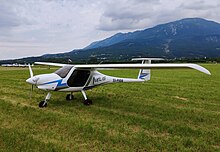
| Part of a series on |
| Aircraft propulsion |
|---|
|
Shaft engines: driving propellers, rotors, ducted fans or propfans |
| Reaction engines |
An electric aircraft is an aircraft powered by electricity. Electric aircraft are seen as a way to reduce the environmental effects of aviation, providing zero emissions and quieter flights. Electricity may be supplied by a variety of methods, the most common being batteries. Most have electric motors driving propellers or turbines.
Crewed flights in an electrically powered airship go back to the 19th century, and to 1917 for a tethered helicopter. Electrically powered model aircraft have been flown at least since 1957, preceding the small unmanned aerial vehicles (UAV) or drones used today. Small UAS could be used for parcel deliveries, and larger ones for long-endurance applications: aerial imagery, surveillance, telecommunications. The first crewed free flight by an electrically powered aeroplane, the MB-E1, was made in 1973, and most crewed electric aircraft today are still only experimental prototypes. The world's first serially produced self-launching, manned electric aircraft with EASA type certification since 2006[1] and a patented wing-integrated battery system,[2] the Lange E1 Antares, completed its maiden flight in 1999; since 2004, more than 100 aircraft of this type have been delivered, totalling more than 165,000 electric flight hours to date (until 2022).[3] Between 2015 and 2016, Solar Impulse 2 completed a circumnavigation of the Earth using solar power. Electric VTOL aircraft or personal air vehicles are being considered for Urban Air Mobility. Electric commercial airliners could lower operating costs.[4]: 1–7
- ^ "EASA Aircraft Type Certificate Data Sheet – EASA-TCDS.A.092 Issue 4 – Lange E1 Antares" (PDF). Retrieved 2024-01-03.
- ^ "Register information Patent DE file number : 195 12 816.8". German Patent & Trade Mark Office. 2011-05-27. Retrieved 2024-01-03.
- ^ ""The most electric flying hours in the world" – "We have more electric flight hours than all other companies and all other aircraft in the world combined." -Axel Lange, CEO Lange Aviation in conversation with Prof. Dr. Otto Künzel at the Berblingen Flight Forum 2022". 31 March 2022. Retrieved 2024-01-03.
- ^ Cite error: The named reference
ACRP-2022was invoked but never defined (see the help page).